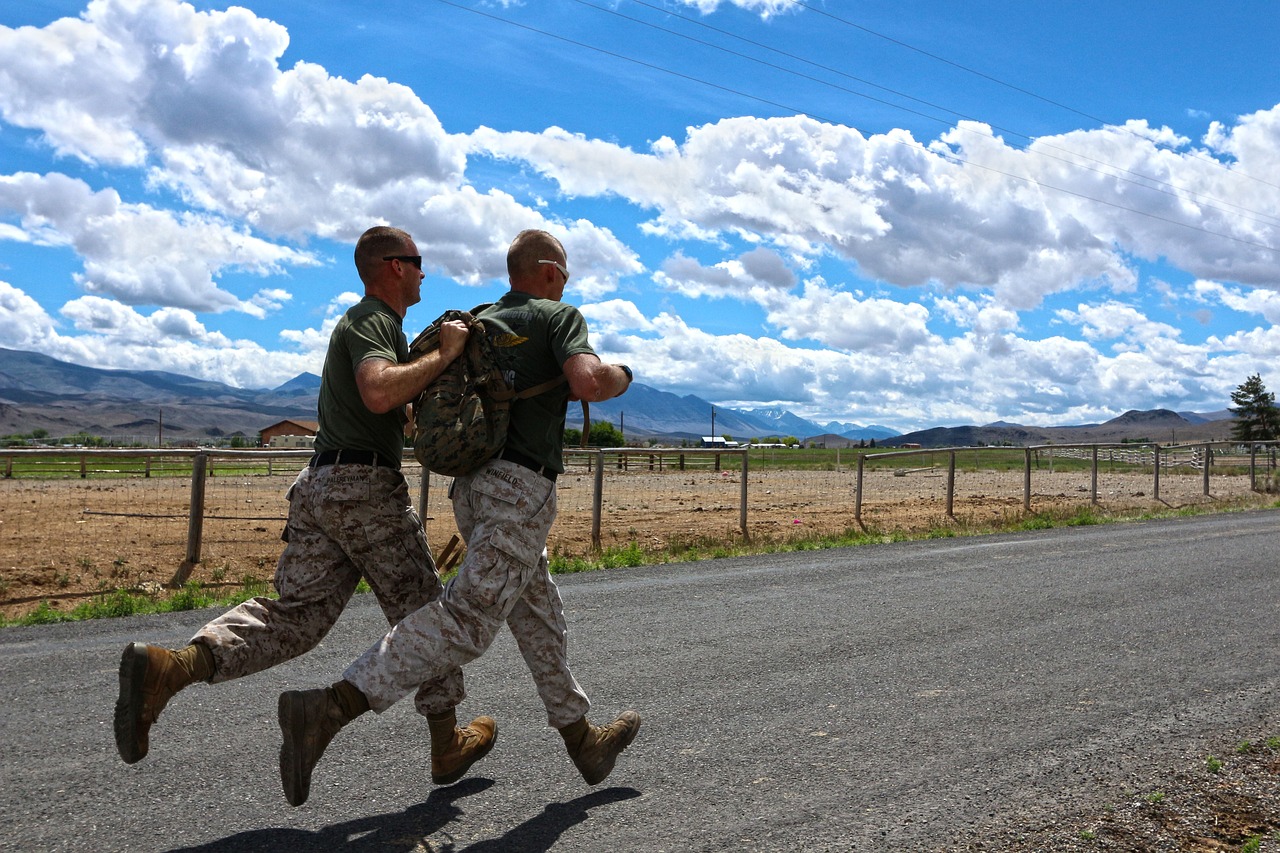How AI is Improving Targeting Accuracy in Combat
In the rapidly evolving landscape of modern warfare, artificial intelligence (AI) stands out as a game-changer, revolutionizing how military operations are conducted. Imagine a battlefield where decisions are made not just based on human intuition but on precise data analysis and real-time insights. This is the new reality, where AI enhances targeting accuracy, allowing military forces to strike with unprecedented precision while minimizing collateral damage. The implications of these advancements are profound, affecting everything from strategic planning to ethical considerations.
To grasp the impact of AI on military operations, it’s essential to understand what AI entails. At its core, AI refers to computer systems designed to perform tasks that typically require human intelligence. These tasks include data analysis, pattern recognition, and decision-making. In the context of warfare, AI can analyze vast amounts of data from various sources, such as satellite imagery, drone footage, and intelligence reports, to provide actionable insights. This capability not only enhances operational efficiency but also significantly improves the accuracy of targeting decisions.
One of the standout features of AI is its ability to process and analyze enormous datasets at lightning speed. Traditional methods of data analysis can be slow and prone to human error, but AI algorithms can sift through terabytes of information in mere seconds. This rapid processing allows military commanders to make informed decisions based on real-time data, ultimately improving targeting accuracy. For instance, AI can analyze patterns in enemy movements and predict their next steps, enabling forces to strike before their adversaries can react.
At the heart of AI's data processing capabilities are machine learning algorithms. These algorithms are designed to learn from data patterns and improve over time. In combat scenarios, machine learning can enhance prediction accuracy by identifying trends and anomalies that might be missed by human analysts. By continuously learning from new data, these algorithms can adapt to changing battlefield conditions, ensuring that military operations remain agile and responsive.
Predictive analytics plays a crucial role in military strategy and operational planning. By analyzing historical data, AI can forecast potential outcomes of various tactical decisions. For example, if a particular strategy has previously resulted in a successful mission, AI can recommend similar approaches in future operations, while also considering current conditions. This not only boosts confidence in decision-making but also enhances the overall effectiveness of military strategies.
Another critical aspect of AI in military operations is real-time data integration. By consolidating information from multiple sources—such as drones, satellites, and ground forces—AI systems can provide a comprehensive picture of the battlefield. This integration enables quicker decision-making, as commanders can access up-to-date information at their fingertips. With timely data, military forces can adjust their strategies on the fly, ensuring that targeting is not only accurate but also relevant to the evolving situation.
The advent of autonomous targeting systems marks a significant leap in military technology. These systems, equipped with AI, can identify and engage targets without direct human intervention. While this capability offers enhanced combat effectiveness, it also raises questions about the implications of such technologies. Autonomous systems can process information and make decisions faster than humans, potentially leading to more effective strikes. However, the absence of human oversight in critical decisions poses risks that must be carefully considered.
As with any technological advancement, the use of AI in military targeting brings forth a host of ethical questions. The ability of machines to make life-and-death decisions challenges traditional notions of accountability and morality in warfare. Who is responsible when an AI system makes a mistake? These questions are not merely theoretical; they have real-world implications for military personnel and civilians alike.
Determining accountability for decisions made by AI-driven systems is complex. If an autonomous system misidentifies a target and causes unintended casualties, who is held responsible? The developers? The military commanders? This ambiguity creates a moral dilemma that must be addressed as AI continues to play a larger role in combat.
Maintaining human oversight in AI targeting is crucial for ethical compliance. While AI can enhance decision-making speed and accuracy, the final call should ideally rest with human operators. Balancing automation with human judgment ensures that ethical considerations are taken into account, especially in high-stakes situations where the consequences of errors can be devastating.
- How does AI improve targeting accuracy? AI processes large datasets quickly, analyzes patterns, and provides real-time insights, leading to more precise targeting.
- What are machine learning algorithms? These are algorithms that allow AI systems to learn from data patterns and improve their predictions over time.
- Are autonomous targeting systems safe? While they can enhance effectiveness, they also raise ethical concerns about accountability and oversight.
- What role does human oversight play in AI targeting? Human oversight is crucial to ensure ethical compliance and accountability in military operations.

Understanding AI in Military Operations
Artificial intelligence, or AI, is not just a buzzword; it's a revolutionary force reshaping the landscape of military operations. Imagine a world where machines can analyze data faster than any human brain, making split-second decisions that could determine the outcome of a battle. Sounds futuristic, right? Well, that future is here, and it's transforming how militaries around the globe strategize and operate. AI is enabling advanced data analysis and decision-making processes that were once thought to be the exclusive domain of human intelligence.
At its core, AI in military operations involves the use of algorithms and machine learning to process and interpret vast amounts of data. This includes everything from satellite imagery to social media analytics. The ability to sift through this information quickly and accurately allows military leaders to make informed decisions based on real-time intelligence. For instance, AI systems can identify patterns in enemy movements, predict potential threats, and even suggest tactical maneuvers that could give an army a strategic advantage.
But how does this all work? Think of AI as a sophisticated digital brain that learns and adapts. It can analyze historical data to understand what has happened in previous conflicts, and then apply that knowledge to current situations. This capability is particularly important in modern warfare, where the speed of information can change the tide of battle in an instant. With AI, military forces can react more swiftly to emerging threats, ensuring that they stay one step ahead of their adversaries.
Moreover, AI's role in military operations isn't limited to just data analysis. It extends to various applications, such as autonomous systems that can operate independently on the battlefield. These systems, equipped with AI, can identify and engage targets without direct human intervention. While this might sound like something out of a sci-fi movie, it raises significant questions about the future of warfare and the ethical implications of machines making life-and-death decisions.
In summary, understanding AI in military operations is crucial for grasping the future of warfare. It combines advanced technology with strategic thinking, allowing for enhanced efficiency and effectiveness on the battlefield. As we delve deeper into the capabilities of AI, we must also consider the ethical dimensions that accompany such powerful tools. After all, with great power comes great responsibility.
- What is AI in military operations? AI in military operations refers to the use of artificial intelligence technologies to enhance decision-making, data analysis, and operational effectiveness in warfare.
- How does AI improve targeting accuracy? AI improves targeting accuracy by processing vast amounts of data quickly, identifying patterns, and providing real-time insights that inform military decisions.
- What are autonomous targeting systems? Autonomous targeting systems are AI-driven technologies that can identify and engage targets without human intervention, raising questions about accountability and ethics in warfare.
- What ethical considerations are associated with AI in warfare? Ethical considerations include accountability for AI-driven decisions, the potential for unintended consequences, and the importance of maintaining human oversight in military operations.

Enhanced Data Processing Capabilities
In the rapidly evolving landscape of military operations, artificial intelligence (AI) is proving to be a game changer, particularly in the realm of data processing. The sheer volume of information generated during combat scenarios can be overwhelming, but AI's ability to sift through this data at lightning speed is revolutionizing how military decisions are made. Imagine trying to find a needle in a haystack; now, envision a machine that not only finds that needle but also tells you exactly where it came from and how to use it effectively. This is the power of AI in enhancing targeting accuracy.
AI systems utilize advanced algorithms to analyze real-time data from various sources, including satellite imagery, drone feeds, and ground reports. By processing this information swiftly and accurately, military strategists can make informed decisions that significantly improve targeting precision. For instance, during a military operation, AI can evaluate the current battlefield situation, assess potential threats, and suggest optimal engagement strategies—all in a matter of seconds. This capability not only saves time but also minimizes risks associated with human error.
One of the key components of AI's enhanced data processing capabilities is its use of machine learning algorithms. These algorithms are designed to learn from historical data and identify patterns that can predict future outcomes. In combat scenarios, this means that AI can analyze past engagements to forecast how similar situations might unfold. For example, if a specific tactic was successful in the past, the AI can recommend its use in a current operation, thereby increasing the likelihood of success.
Machine learning is essentially the brain behind AI's decision-making prowess. It allows systems to continuously improve their performance by learning from new data. This is akin to a soldier who learns from each mission, becoming more adept at identifying threats and making split-second decisions. The more data the AI processes, the better it becomes at predicting outcomes and enhancing targeting accuracy. This capability is crucial in high-stakes environments where every second counts and the margin for error is razor-thin.
Another significant aspect of AI's data processing capabilities is predictive analytics. This involves using historical data to forecast potential outcomes and inform military strategy. By analyzing past conflicts, AI can identify trends and insights that help commanders anticipate enemy movements and devise effective counter-strategies. For example, if data indicates that an enemy unit tends to regroup in a specific area after an attack, commanders can use this information to plan ambushes or aerial strikes with greater accuracy.
Furthermore, the integration of real-time data from various sources is pivotal in enhancing targeting precision. AI systems can merge data from satellites, drones, and ground sensors to create a comprehensive situational awareness picture. This is similar to piecing together a jigsaw puzzle; when all the pieces are in place, the full image becomes clear. The ability to access and process this information in real-time allows military leaders to make quicker, more informed decisions, ultimately leading to improved operational outcomes.
In summary, the enhanced data processing capabilities offered by AI are transforming military operations. From machine learning algorithms that learn and adapt to predictive analytics that forecast potential outcomes, AI is equipping military strategists with the tools they need to enhance targeting accuracy. As we move forward, the implications of these advancements will continue to shape the future of warfare, making it more precise and potentially less costly in terms of human life.
- How does AI improve targeting accuracy? AI enhances targeting accuracy by processing vast amounts of data quickly and analyzing patterns through machine learning algorithms.
- What role do machine learning algorithms play in military operations? Machine learning algorithms allow AI systems to learn from historical data, improving their prediction accuracy in combat scenarios.
- Why is real-time data integration important? Real-time data integration is crucial as it enables timely decision-making, allowing military leaders to respond swiftly to changing battlefield conditions.
- What are the ethical considerations of using AI in warfare? The use of AI in warfare raises questions about accountability for AI-driven decisions and the need for human oversight in targeting operations.

Machine Learning Algorithms
Machine learning algorithms are at the forefront of revolutionizing how we approach warfare and military strategy. These sophisticated systems are designed to learn from vast datasets and improve their performance over time, much like how a seasoned soldier hones their skills through experience. Imagine a soldier who, after each mission, analyzes their actions and outcomes to become more effective in future engagements. That's precisely what machine learning does, but on a much larger and faster scale.
At the core of machine learning is the ability to identify patterns within data. For instance, in combat scenarios, these algorithms can process information from various sources—intelligence reports, satellite imagery, and drone footage—to predict enemy movements and identify potential threats. This capability is akin to having an all-seeing eye that not only observes but also interprets the battlefield dynamics in real-time.
To understand the impact of these algorithms, let's delve into a few key types:
- Supervised Learning: This method requires labeled datasets to train the model. By feeding the algorithm examples of past engagements, it can learn to distinguish between different types of targets and their characteristics.
- Unsupervised Learning: In contrast, this approach allows the algorithm to explore data without predefined labels. It identifies hidden patterns, which can be critical in discovering new enemy tactics or adapting to unforeseen circumstances.
- Reinforcement Learning: Here, the algorithm learns by receiving feedback from its actions. Think of it as a game where the AI receives rewards for making the right decisions, thus encouraging it to refine its strategies continuously.
These algorithms significantly enhance prediction accuracy in combat scenarios. For example, during military operations, AI systems can analyze historical data to determine the likelihood of an enemy attack at a specific location. This predictive capability allows commanders to allocate resources more effectively and make informed decisions that can mean the difference between success and failure on the battlefield.
Moreover, the integration of machine learning with predictive analytics further amplifies its effectiveness. By combining past data with real-time intelligence, military strategists can forecast potential outcomes based on various scenarios. This proactive approach not only enhances operational planning but also minimizes risks by preparing for multiple contingencies.
In addition, machine learning algorithms can adapt to new data inputs almost instantaneously. This means that as the situation on the ground evolves, the AI can recalibrate its predictions and recommendations, ensuring that military leaders are always equipped with the most accurate and timely information. It's like having a personal assistant who not only reminds you of your schedule but also predicts the best routes to avoid traffic based on real-time conditions.
In summary, machine learning algorithms are not just tools; they are transformative technologies that redefine how militaries operate. Their ability to learn, adapt, and predict makes them invaluable in enhancing targeting accuracy, ultimately leading to more successful mission outcomes. However, as we embrace these advancements, we must also consider the ethical implications and ensure that human oversight remains a cornerstone of military operations.
- What are machine learning algorithms? Machine learning algorithms are systems that learn from data to improve their performance over time, making them capable of identifying patterns and making predictions.
- How do these algorithms enhance targeting accuracy? By processing vast amounts of data quickly, machine learning algorithms can analyze past engagements and predict enemy movements, leading to more precise targeting.
- What types of machine learning are used in military operations? The main types include supervised learning, unsupervised learning, and reinforcement learning, each serving different purposes in data analysis and decision-making.
- Why is human oversight important in AI targeting? Human oversight ensures ethical compliance and accountability, balancing the efficiency of AI with the moral responsibilities of military operations.

Predictive Analytics in Combat
Predictive analytics is revolutionizing the way military strategies are formulated and executed. By utilizing historical data, advanced algorithms can forecast potential outcomes with remarkable accuracy. Imagine having a crystal ball that not only reveals the future but also provides insights based on past events. That's essentially what predictive analytics does for combat scenarios. It analyzes patterns and trends from previous engagements, allowing military strategists to make informed decisions that could mean the difference between success and failure on the battlefield.
One of the most compelling aspects of predictive analytics is its ability to synthesize vast amounts of data from various sources. This means that information from satellite imagery, reconnaissance reports, and even social media can be combined to create a comprehensive picture of the battlefield. For instance, if a certain area has seen increased troop movements in the past, predictive models can alert commanders to potential threats or opportunities in that region. This proactive approach not only enhances operational efficiency but also reduces the risks associated with surprise attacks.
Furthermore, predictive analytics can assist in resource allocation, ensuring that troops and equipment are deployed where they are most needed. By analyzing factors such as terrain, weather conditions, and enemy movements, military leaders can optimize their strategies. This can be likened to a chess game, where each move is calculated based on the opponent's previous actions. The ability to anticipate the enemy's next move can provide a significant tactical advantage.
However, it’s essential to recognize that predictive analytics is not infallible. The accuracy of forecasts depends heavily on the quality and relevance of the data fed into the system. If the data is flawed or outdated, the predictions can lead to catastrophic consequences. This emphasizes the need for continual updates and validation of the data used in these models. Military organizations must invest in robust data management systems to ensure that their predictive analytics tools remain effective.
In conclusion, predictive analytics in combat is a powerful tool that enhances decision-making and operational effectiveness. By leveraging historical data and advanced algorithms, military strategists can anticipate threats, allocate resources efficiently, and ultimately improve their chances of success. As technology continues to evolve, the role of predictive analytics in warfare will likely expand, making it an indispensable part of modern military operations.
- What is predictive analytics in combat?
Predictive analytics in combat refers to the use of historical data and algorithms to forecast potential outcomes in military operations, helping strategists make informed decisions.
- How does predictive analytics improve military strategies?
It enhances military strategies by analyzing past data patterns, which helps in anticipating enemy actions, optimizing resource allocation, and improving overall operational effectiveness.
- What are the risks associated with predictive analytics?
The primary risk is the reliance on flawed or outdated data, which can lead to incorrect predictions and potentially disastrous outcomes.
- Can predictive analytics replace human decision-making in combat?
No, while predictive analytics can provide valuable insights, human judgment remains crucial for ethical and strategic considerations in military operations.

Real-Time Data Integration
In the fast-paced world of modern warfare, has emerged as a game-changer, significantly enhancing targeting accuracy. Imagine being in a high-stakes game of chess, where every move counts, and you have access to not just your pieces but also your opponent's strategies in real-time. This is the essence of how AI integrates data from various sources to provide military commanders with a comprehensive view of the battlefield.
Real-time data integration involves the seamless amalgamation of information from numerous platforms, including satellite imagery, drone surveillance, and ground sensors. By synthesizing this data, AI systems can create a dynamic and up-to-the-minute picture of the operational environment. This capability allows commanders to make informed decisions swiftly, adapting to changing circumstances on the ground. For instance, if enemy positions shift or new threats emerge, the AI can alert personnel instantly, ensuring that strategies remain relevant and effective.
Moreover, the integration of real-time data is not just about speed; it’s also about accuracy. When AI algorithms analyze incoming data streams, they can identify patterns and anomalies that human operators might overlook. This heightened level of detail can mean the difference between a successful operation and a catastrophic failure. In fact, studies have shown that military operations utilizing integrated real-time data report a significant increase in targeting precision, which ultimately leads to better mission outcomes.
Furthermore, the importance of timely information cannot be overstated. In military operations, every second counts. The faster a commander can assess a situation and respond, the better the chances of mission success. For example, consider a scenario where ground troops are engaged in combat. If real-time data from aerial drones can pinpoint enemy locations and movements, commanders can deploy resources more effectively, ensuring that their forces are always one step ahead.
To illustrate the impact of real-time data integration, let’s look at a simplified example:
| Data Source | Type of Information | Impact on Targeting |
|---|---|---|
| Satellite Imagery | Geospatial data, troop movements | Identifies enemy formations and provides strategic insights |
| Drone Surveillance | Real-time video feeds | Enables precise targeting and minimizes collateral damage |
| Ground Sensors | Movement detection, environmental changes | Alerts to changes in enemy tactics or reinforcement |
As we can see from the table above, various data sources contribute uniquely to the overall targeting strategy, enhancing the effectiveness of military operations. The integration of these data streams allows for a holistic understanding of the battlefield, fostering an environment where informed decisions can lead to successful outcomes.
In conclusion, real-time data integration is not merely a technological advancement; it is a crucial component of modern military strategy. By leveraging AI to process and analyze vast amounts of information instantaneously, armed forces can achieve unprecedented levels of targeting accuracy. As we move forward, the continued evolution of these technologies will undoubtedly shape the future of warfare, making it imperative for military leaders to embrace and adapt to these innovations.
- What is real-time data integration in military operations? Real-time data integration refers to the process of combining information from various sources to provide a comprehensive and up-to-date view of the battlefield, allowing for quick and informed decision-making.
- How does AI improve targeting accuracy? AI enhances targeting accuracy by processing vast amounts of data quickly, identifying patterns, and providing actionable insights that inform military strategies.
- What are the ethical implications of using AI in warfare? The use of AI in warfare raises questions about accountability, human oversight, and the moral implications of autonomous decision-making in combat scenarios.

Autonomous Targeting Systems
In the ever-evolving landscape of modern warfare, are at the forefront of technological advancement. These systems leverage artificial intelligence to identify and engage targets with minimal human intervention, fundamentally altering the dynamics of combat. Imagine a scenario where machines can assess threats and make split-second decisions that could mean the difference between victory and defeat. This is not science fiction; it's a reality that is being shaped by the rapid development of AI technologies.
One of the key benefits of autonomous targeting systems is their ability to process information faster than any human could. With the integration of advanced algorithms and real-time data, these systems can analyze vast amounts of information, including satellite imagery, reconnaissance reports, and battlefield conditions. For instance, they can evaluate the movement patterns of enemy forces and predict their next moves, all while filtering out irrelevant data. This capability not only enhances the effectiveness of military operations but also minimizes the risk of collateral damage.
However, the deployment of autonomous systems in combat raises significant questions about combat effectiveness and safety. While these systems can operate in high-risk environments without putting human lives on the line, their use also introduces a level of unpredictability. For example, if a machine misidentifies a target, the consequences could be dire. This possibility underscores the need for rigorous testing and validation of these systems before they are fully deployed in combat scenarios.
Moreover, the implications of autonomous targeting systems extend beyond the battlefield. They challenge traditional military hierarchies and decision-making processes. In a world where machines can make tactical decisions, the role of human commanders may shift significantly. Will military leaders become mere overseers of technology, or will they still play a critical role in strategic planning? These questions provoke thoughtful discussions about the future of warfare and the human element within it.
To better understand the impact of autonomous targeting systems, consider the following table that highlights their key features and potential challenges:
| Feature | Benefits | Challenges |
|---|---|---|
| Speed of Decision-Making | Faster response times in combat situations | Potential for errors in target identification |
| Data Processing | Ability to analyze vast amounts of data in real-time | Risk of information overload |
| Human Oversight | Reduction of human casualties | Ethical concerns regarding accountability |
As we delve deeper into the implications of these systems, it becomes clear that while they offer numerous advantages in terms of efficiency and effectiveness, they also pose significant ethical dilemmas. The balance between automation and human judgment is delicate, and finding the right equilibrium is critical for the responsible use of autonomous targeting systems in military operations.
- What are autonomous targeting systems?
Autonomous targeting systems are AI-driven technologies that can identify and engage military targets without human intervention. - How do these systems improve military operations?
They enhance targeting accuracy, reduce response times, and minimize the risk to human soldiers by operating in high-risk environments. - What are the ethical concerns surrounding their use?
Key ethical issues include accountability for decisions made by machines and the potential for collateral damage due to misidentification of targets. - Will humans still play a role in military decision-making?
Yes, while autonomous systems can assist in decision-making, human oversight remains essential to ensure ethical compliance and strategic planning.

Ethical Considerations of AI in Warfare
As we delve into the realm of artificial intelligence in military operations, we can't ignore the ethical implications that come with it. The integration of AI in warfare is not just a technological advancement; it raises profound moral questions that challenge our understanding of accountability, responsibility, and the very nature of combat. Can machines make decisions that involve life and death? This question looms large as we explore how AI systems are designed to operate autonomously in the battlefield.
One of the most pressing issues is the question of accountability. When an AI system makes a decision that leads to unintended consequences, such as civilian casualties or targeting errors, who is held responsible? Is it the programmer who designed the algorithm, the military personnel who deployed the system, or the AI itself? The complexity of assigning blame in these scenarios creates a murky legal landscape that is yet to be fully addressed. As we push the boundaries of technology, we must also consider the legal frameworks that govern these actions.
Moreover, the concept of human oversight in AI targeting systems is crucial. While AI can process data and make decisions faster than a human, the absence of human judgment can lead to catastrophic outcomes. Imagine a scenario where an autonomous drone identifies a target based solely on data inputs without understanding the broader context. This is where the balance between automation and human intervention becomes essential. Military strategies must ensure that a human operator is always in the loop, capable of overriding decisions made by AI systems, especially in complex and dynamic combat environments.
In the pursuit of enhancing targeting accuracy, we must also consider the potential for bias in AI algorithms. If the data fed into these systems is flawed or biased, the decisions made can exacerbate existing inequalities or lead to unjust outcomes. For instance, if an AI system is trained on historical data that reflects biased military engagements, it may replicate those biases in its targeting decisions. This raises the question: how do we ensure that AI systems are fair and just in their operations?
As military forces around the globe adopt AI technologies, it is imperative to establish ethical guidelines that govern their use. These guidelines should address not only the technical aspects of AI deployment but also the moral responsibilities that come with it. Key considerations might include:
- Ensuring transparency in AI decision-making processes.
- Implementing rigorous testing and evaluation to minimize errors.
- Establishing clear accountability mechanisms for AI-driven actions.
- Maintaining human oversight to ensure ethical compliance.
In conclusion, while AI offers significant advancements in targeting accuracy and operational efficiency, we must tread carefully. The ethical considerations surrounding its use in warfare demand our attention and action. As we continue to innovate, we must also reflect on the kind of future we are creating with these technologies and strive to ensure that they are used responsibly and ethically.
- What are the main ethical concerns regarding AI in warfare? The primary concerns include accountability for AI decisions, the necessity of human oversight, and the potential for bias in algorithms.
- How can we ensure accountability in AI-driven military actions? Establishing clear legal frameworks and guidelines for accountability can help address this challenge.
- Is human oversight still necessary in AI operations? Yes, human oversight is crucial to ensure ethical compliance and to make nuanced decisions that AI may not be capable of.
- What role does bias play in AI targeting? Bias in AI can lead to unjust outcomes if the data used to train these systems reflects historical inequalities or prejudices.

Accountability in AI Decisions
When we talk about , we're diving into a complex web of ethics, responsibility, and the implications of technology in warfare. Imagine a world where machines make life-and-death decisions without human intervention. It sounds like something out of a sci-fi movie, right? But this is rapidly becoming a reality with the rise of autonomous systems in military operations.
One of the biggest challenges we face is determining who is responsible when AI systems make a mistake. For instance, if an autonomous drone mistakenly targets a civilian area instead of a military one, who is held accountable? Is it the programmer who designed the algorithm, the military personnel who deployed the system, or the AI itself? This ambiguity can lead to significant moral and legal dilemmas.
To understand this better, let’s break down the accountability issue into three key areas:
- Design Responsibility: The creators of AI systems must consider the ethical implications of their designs. This includes ensuring that algorithms are trained on diverse datasets to minimize bias.
- Operational Oversight: Military commanders need to maintain a level of oversight over autonomous systems. This ensures that human judgment is applied, especially in critical situations.
- Legal Framework: There is a pressing need for updated laws and regulations that address the use of AI in warfare. These laws should clarify accountability and establish guidelines for the ethical use of these technologies.
Moreover, the concept of explainable AI is crucial in this conversation. It refers to AI systems that can provide clear reasoning for their decisions. If an AI can explain why it chose a particular target, it becomes easier to assess responsibility and accountability. The transparency of AI operations can foster trust and ensure ethical compliance in military engagements.
In conclusion, as we integrate AI into military operations, we must tread carefully. The balance between leveraging advanced technology for strategic advantages and maintaining ethical standards is delicate. We are at a crossroads where the decisions made today will shape the future of warfare and accountability in the age of AI.
- Who is responsible for AI decisions in military operations? Accountability can fall on various parties, including AI developers, military commanders, and even the AI systems themselves, depending on the context of the decision.
- What is explainable AI? Explainable AI refers to systems that can articulate the reasoning behind their decisions, which is essential for accountability and trust.
- How can military organizations ensure ethical AI use? By implementing strict oversight, transparent algorithms, and clear legal frameworks, military organizations can work towards ethical AI use in combat.

Human Oversight in Targeting
In the realm of modern warfare, the integration of artificial intelligence (AI) into targeting systems presents both incredible opportunities and significant challenges. While AI can enhance efficiency and precision, the need for human oversight remains paramount. After all, technology, no matter how advanced, cannot fully replicate the nuanced understanding and ethical considerations that human operators bring to the table.
Imagine a scenario where an autonomous drone identifies a target based solely on predefined algorithms. Without human intervention, there is a risk that the drone could misinterpret the situation, leading to unintended consequences. This is where the critical role of human oversight comes into play. It acts as a safeguard, ensuring that decisions made by AI systems align with ethical standards and the rules of engagement.
The importance of human oversight can be broken down into several key aspects:
- Ethical Responsibility: Humans must ensure that AI systems operate within moral boundaries. This includes making decisions that prioritize the protection of civilian lives and adhere to international laws.
- Contextual Understanding: AI may struggle with context, especially in dynamic combat environments. Human operators can assess situations more holistically, considering factors that algorithms might overlook.
- Accountability: In cases where AI makes a mistake, determining accountability is crucial. Maintaining human oversight helps clarify who is responsible for decisions made in the heat of battle.
Furthermore, the balance between automation and human judgment is not just a matter of ethics; it also influences operational effectiveness. In high-pressure situations, human intuition can be invaluable. For instance, during a military operation, a commander might recognize the importance of holding fire despite an AI system indicating a clear shot. This ability to pause and reassess can prevent catastrophic errors.
As military organizations continue to advance their use of AI, training programs must evolve as well. Future military personnel will need to be adept not only at using these technologies but also at understanding their limitations. This dual focus on technology and ethics will ensure that human oversight remains a cornerstone of military operations.
In conclusion, while AI enhances targeting accuracy, the role of human oversight cannot be understated. It is essential for ensuring that the use of these advanced systems aligns with ethical standards and operational effectiveness. As we move forward, striking the right balance between human judgment and machine efficiency will be critical in shaping the future of warfare.
- Why is human oversight necessary in AI targeting systems? Human oversight is crucial to ensure ethical decision-making, contextual understanding, and accountability in military operations.
- How can military personnel be trained to oversee AI systems effectively? Training should focus on both technological proficiency and ethical considerations, preparing personnel to make informed decisions in complex situations.
- What are the risks of relying solely on AI for targeting? Sole reliance on AI can lead to misinterpretations of situations, ethical violations, and a lack of accountability for decisions made in combat.
Frequently Asked Questions
- How does AI improve targeting accuracy in military operations?
AI enhances targeting accuracy by analyzing vast amounts of data rapidly and identifying patterns that human operators might miss. This capability allows military strategists to make informed decisions based on real-time information, which is crucial in high-stakes environments.
- What role do machine learning algorithms play in combat scenarios?
Machine learning algorithms enable AI systems to learn from historical data and adapt to new situations. By recognizing trends and predicting outcomes, these algorithms significantly improve the accuracy of target identification and engagement in combat scenarios.
- Can AI systems operate autonomously in combat?
Yes, AI systems can operate autonomously, identifying and engaging targets without human intervention. However, this raises important questions about safety and effectiveness, as well as the ethical implications of allowing machines to make life-and-death decisions.
- What are the ethical considerations surrounding AI in warfare?
The use of AI in warfare brings up several ethical concerns, including accountability for decisions made by autonomous systems and the potential for loss of human oversight. It's essential to find a balance between leveraging technology and ensuring that human judgment remains a key component in military operations.
- How important is human oversight in AI targeting?
Human oversight is crucial in AI targeting to ensure ethical compliance and accountability. While AI can process information faster, human judgment is necessary to interpret data accurately and make decisions that align with moral and ethical standards.
- What is predictive analytics, and how is it used in military strategy?
Predictive analytics involves using historical data to forecast future outcomes. In military strategy, it helps commanders anticipate enemy movements and plan operations more effectively, ultimately improving targeting accuracy and mission success.
- How does real-time data integration enhance military decision-making?
Integrating real-time data from multiple sources allows military leaders to make quicker and more informed decisions. This timely access to information is critical for improving targeting precision and responding effectively to dynamic battlefield conditions.



















